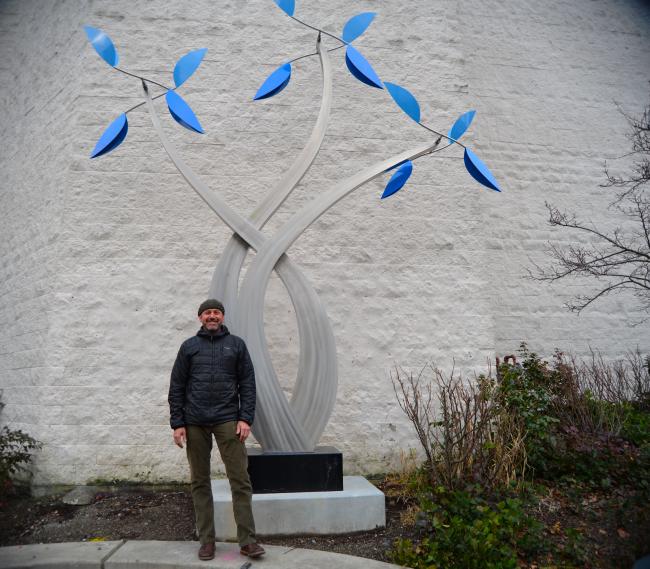Artist putting finishing touches on Junction Plaza Park sculpture
West Seattle artist Troy Pillow's newest piece “Transpose” is at home in the sculptor's own neighborhood -- at Junction Plaza Park, located just at the corner of 42nd and Alaska.
Mon, 02/06/2017
by Lindsay Peyton
West Seattle artist Troy Pillow is preparing to put the finishing touches on his sculpture “Transpose” at Junction Plaza Park, located just at the corner of 42nd and Alaska.
The kinetic homage to the park – reflecting the intersection of nature and the bustling shopping and dining district – was erected at the end of November. Now Pillow is installing lights to let the stainless steel piece continue to glow at night.
The sculpture has become an anchor to the plaza. The small park features a few benches and a small lawn, perfect for a moment’s relaxation.
Now when the wind blows, the bright blue leaves on the metal tree whirl like a pinwheel – adding a bit of eye-catching whimsy to the public space.
Pillow said the park was dedicated in 2010 and that funding became available and made it possible for the installation of a sculpture.
He was selected by the West Seattle Junction Association for the project and, together with the organization, sought public input for the design.
He began fabricating the sculpture last September.
“It’s a representation of the Junction,” Pillow said. “The interconnecting lines and curves are meant to represent the constant crossing paths of the people. The junction is the busiest intersection in West Seattle.”
He added that the lines in the piece are meant to be organic – to symbolize the natural spaces nearby and in the park.
Lora Swift, executive director of the West Seattle Junction Association, is impressed with the results.
“This was the perfect opportunity to bring art to a West Seattle neighborhood park,” she said. “We selected Troy through community outreach. He had a vision that tracked well with the neighborhood, and the sculpture is beautiful.”
Swift said working with Pillow on the project was a rewarding experience. “He’s just a total professional,” she said. “He’s a very talented artists, and we’re extremely happy with the final project. We look forward to collaborating with Troy again if the opportunity arises.”
Art was not what Pillow initially imagined as his calling.
“I took a different path than most people,” he said.
He pursued aerospace engineering while attending college in his home state at the University of Colorado Boulder. He left school to start a company selling clothing for skiing and snowboarding.
Pillow credits the early enterprise with teaching him the basics of fabrication and business – skills he later used to start building metal furniture.
“It was basically the same concept – taking that flat piece of metal and forming it,” he said. “One day, I decided to make something sculptural and less utilitarian.”
He ended up with a giant piranha formed from metal – and convinced a friend who owned a vacant lot to let him place the piece outside for sale.
“I put a sign on it and sold it in a week,” Pillow said. “I asked if he minded if I kept putting stuff out there. He said, ‘Go for it.’”
Pillow’s venture into sculpting was becoming his new profession. He taught himself the ropes -- and dove right in.
He had to learn the materials, what finishes to use and what would make the pieces durable despite the elements.
“My engineering background kicked in,” Pillow said. “Then I was able to use it to make the sculptures move in the wind.”
He eventually opened a 3,000-sq. ft. outdoor sculpture gallery in Denver.
When Pillow learned about the range of art festivals across the country, he hit the road.
As he traveled, he earned a major following.
“It enabled me to collect email addresses and create a client base,” he said. “I also got to travel around and see other markets. I didn’t grow up around the arts. I was trying to figure out what it was all about.”
New software allowed him to create three-dimensional mock-ups of his moving artwork – and he was able to work on commissioned pieces for clients all over the U.S.
“I was doing fine on my own, using all these tools, but I wanted to see if I could make it in a big city,” Pillow said. “My goal was to see if I could keep it going.”
He packed up and moved to the San Francisco Bay Area – and at the end of four years, he was represented by three different galleries. His work was also being shown in Santa Fe, New York and Las Vegas.
About 12 years ago, Pillow decided to make another move – this time to Seattle. He found a studio in the International District and set up a few sculptures in the yard.
“I was up to my old tricks again,” he said.
Still, he wanted to take his work to the next level – and envisioned his 10-ft. tall sculptures stretching even further up.
Pillow applied to calls for public art – and was accepted. He now has about 10 large-scale works around Seattle, with the newest one Junction Plaza Park.
He is also working on a handful of new pieces to be installed at the Whittaker, a luxury apartment complex located at 4755 Fauntleroy Way SW, as well as a number of other projects with developers around the city.
“I’m also constantly trying to keep galleries full with work,” he said. “And I do everything myself. In between large jobs, I’m filling up the yard, working on commissions.”
Despite his constant, busy schedule, Pillow said he is happiest challenging himself to try new things.
He spends most days in the studio and invites guests to schedule a visit and see the work themselves. For more information, visit www.pillowstudios.com.


